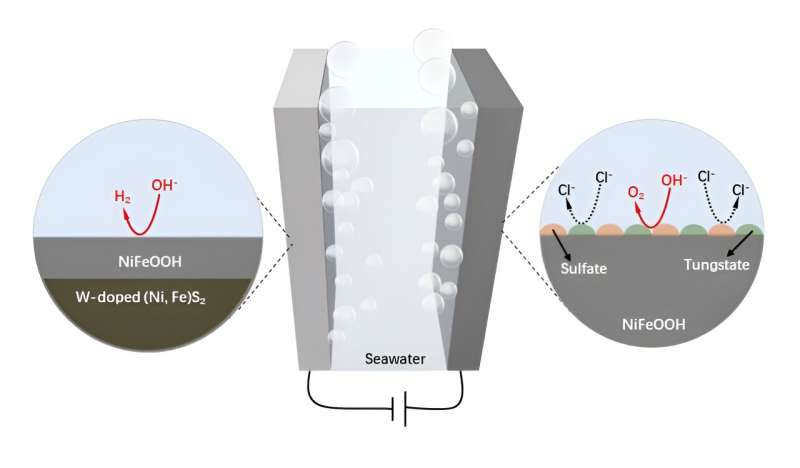Science
Related: About this forumInnovating sustainable hydrogen production via seawater electrolysis

Innovating sustainable hydrogen production via seawater electrolysis
Science China Press | August 13, 2024
Seawater electrolysis holds immense promise as a means to decarbonize the global energy sector. However, challenges such as anode corrosion by chloride ions, unwanted chloride oxidation reactions, and the high cost of catalysts have hindered direct seawater electrolysis.
To address these issues, self-supported nickel-iron (NiFe) materials have emerged as attractive bifunctional catalysts for both hydrogen evolution and oxygen evolution due to their high intrinsic activity and affordability. Wood-based carbon (WC) structures have gained attention as an ideal substrate for these active materials due to their hierarchical porous nature and excellent conductivity.
In a bid to enhance the stability of NiFe-based electrodes in seawater electrolysis, a new approach was devised by Prof. Hong Chen (Southern University of Science and Technology in China), Prof. Bing-Jie Ni (University of New South Wales in Australia), and Prof. Zongping Shao (Curtin University in Australia). The research is published in the journal Science Bulletin.
Through the introduction of tungsten into the active NiFe-based catalysts, the anti-corrosion properties and stability of the anodes were significantly improved. The innovative WC-supported W-doped NiFe sulfide (W-NiFeS/WC) electrode was developed for efficient overall seawater electrolysis through a specialized preparation method involving impregnation and sulfidation...more
https://techxplore.com/news/2024-08-sustainable-hydrogen-production-seawater-electrolysis.html
China's long term hydrogen strategy (they're not expecting this to happen in 6 months)
Hydrogen Industry Development Plan (2021-2035)
Source: International Energy Agency
https://www.iea.org/policies/16977-hydrogen-industry-development-plan-2021-2035
China's not green? Plenty of blame to go around. For example:
China, South Korea are top destinations for US LNG in July as Europe's market share drops
China and South Korea each received 11 US LNG cargoes in July, followed by Japan with nine, and India, the Netherlands and Argentina, each with eight, Commodity Insights data showed.
https://www.spglobal.com/commodityinsights/en/market-insights/latest-news/lng/080224-china-south-korea-are-top-destinations-for-us-lng-in-july-as-europes-market-share-drops
Think. Again.
(15,636 posts)...had retro-fitted an abandoned sea oil rig and used it as either a solar or wind powered electrolyzer to produce H2 from seawater.
eppur_se_muova
(36,954 posts)NNadir
(34,093 posts)This is why it remains as trivial as so called "renewable energy" for the purpose of producing the difficult to handle gas hydrogen.
The International Journal of Hydrogen Energy is now approaching half a century of publication, with the first issue being published in 1976. For about 30 years or so, I've popped over to its pages from time to time, either for laughs or to see about some esoteric thermochemical cycle. Once in a while, rarely, there are interesting, if less than practical papers.
There are always electrolysis papers, oodles and oodles and oodles of them, none of which have placed much of a dent in the practice of steam reforming of dangerous fossil fuels, chiefly gas (and especially in China) coal to make this hard to handle, store, and use gas which is nonetheless an important captive intermediate in the Haber-Bosch process and in oil refining, followed by methanol synthesis. No one has by the way ever overcome (as it is physically impossible) the loss of energy to both Faradaic and Thermodynamic efficiency of electrolysis.
The electrolysis papers all offer ways to avoid the use of expensive platinum anodes, and in the case of seawater electrolysis, how to deal with toxic chlorine and bromine side products.
There has been, really, "hydrogen economy" bullshit even before 1976; 1976 was when the daydream became popular enough to hype it. It's now been picked up by the fossil fuel industry as a tool to greenwash their product, claiming hydrogen is "green," by advertising electrolysis, which is even thermodynamically more odious than steam reforming, since, again, electricity itself is thermodynamically degraded.
It remains true that hydrogen is a A Giant Climate Lie: When they're selling hydrogen, what they're really selling is fossil fuels.
Salespeople are cute when they try to talk about science when advertising their products.
Have a swell day.